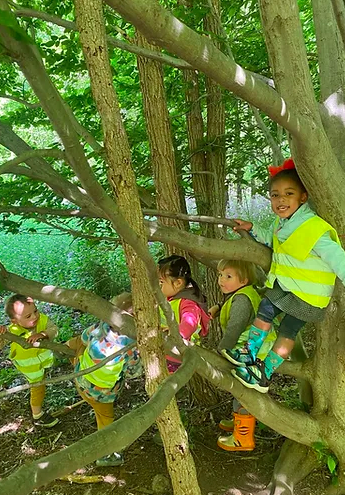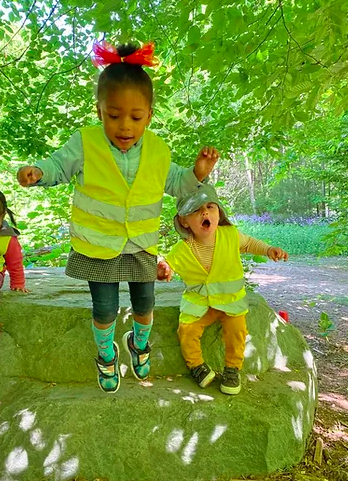Resilience Through Struggle: Helping Children Build the Muscle of Persistence
By: Heather Norcross, environmental steward, social worker, and BOPN lead teacher with a hand for writing and a mind for discovery!
Trying Moments
There is nothing quite like the joy a child expresses when they accomplish a difficult task for the first time. A child’s calls of “Look, I did it!” and “I did it by myself!” are songs of triumph. In witnessing these events, we must acknowledge that this particular sense of pride is simply not possible without struggle. As adults, we are driven to protect our children, wanting to keep their bodies safe from harm and their minds safe from negative emotions. In Nature Preschools and Forest Kindergartens, educator David Sobel writes that in order to keep children safe, they need to learn to assess and take risks so they can understand exactly what they are capable of. It then becomes important to remind ourselves that protecting a child from too many challenging experiences may in fact be depriving them of the opportunities they need to develop problem-solving skills and the wherewithal to persevere.
So much of modern media culture prizes the appearance of perfection, seeking a polished end result that appears effortless. When perfection seems to be the most worthy goal, this can create an incredible amount of pressure that leads to anxiety about getting everything right the first time. If you try and then miss the mark, this pressure sends you the message that you have failed, leading to shame and a sense of despair. Both children and adults are not immune to these influences. Who wouldn’t want to sit down and give up under the weight of all that? Who wouldn’t cry, feeling fearful and angry at the same time? In those disappointing moments, trying can feel futile and a sense of pride and accomplishment feels so far away. But in real life, effort is not the enemy. The need for persistence is not a sign of failure.
A certain sage (and sage green) elder from the Star Warsuniverse once said: “Do or do not, there is no try.” Did Yoda get it all wrong? Perhaps the trying is the doing. Trying is the thing that we need to be able to do. There is no doubt that a key aspect of a well-adjusted child’s life is developing resilience in the face of adversity. This means strengthening the ability to cope with disappointment and difficulty to the point where they believe in their own ability to persist. If at first you don’t succeed, try and try again. With these ideas in mind, we look at what experiences can be most beneficial to children who are freshly building their own framework on how to understand themselves and their own place in the world.
We seek the kinds of activities that can help them ponder these questions:
What do I like doing?
What am I good at?
What makes other people proud of me?
What makes me feel proud of myself?
What can I do if I keep trying?
Rock Star Moments
At the Arnold Arboretum, I find myself assisting 3-6 year olds while they navigate rock climbing on a very low boulder, about the height of my waist, in the Hemlock Hill adventure spot. Even though it is well-monitored, this kind of developmentally-necessary risky play takes me some getting used to, as it is early in my teaching role with BOPN! These activities resemble my own outdoor childhood, but are also a far cry from the risk-averse philosophies now found in many traditional preschool programs. Risky play almost feels counter-intuitive when every cell in my being wants to love and protect young children. Understanding the benefits of risk is key to making sure adult reservations don’t get in the way of learning opportunities. As David Sobel writes, “risk is beneficial for children’s development because it gives them a chance to experience their own limits, work on expanding limits where possible, and accepting limits that can’t be expanded.” Over time we see that children who learn to evaluate risk make better choices.
Here beside this small boulder, I start to see the learning unfold before my eyes. Several children dive on the rock and start climbing, and one hangs back to watch. When this child asks to be placed on the top of the rock, I direct them to check in with the other classmates to see if one might demonstrate how to climb, letting them know I was happy to assist their efforts. This child is not pleased by my answer and lets it be known by giving a little stomp: “I just want to be on top!” I acknowledge the child’s frustration and invite others to share their climbing techniques. Many children jump at the chance to act as teacher, showing gentleness and encouragement to their friend. You can see the brain connections buzzing as they coordinate directional words with their limbs and make space for each other's bodies.
This child struggles with the unfamiliar movements, and their feet slide back to the ground several times. “I’m not good at this!” they yell. “I believe in you!” I say, recommending that they keep trying because they have gotten a little further up each time. After multiple attempts, this child focuses in on what the other children are doing, telling me where they saw hands and feet going and replicating the motions with more precision. In a final hoist, this child reaches the highest point! A piercing cry of “I did it!” rings through the adventure spot, and other children stop what they are doing and turn to look. This child is beaming with a smile from ear to ear, and the pride is radiating like heat waves as they sit on the little summit and take in the view from the top. I sing all the praises: “I’m so proud of you! Look what you did when you kept trying! You can do hard things!” I know this child feels like a true rock star, and next time something seems difficult, they may remember this moment.
Growth Moments
Imagine what would have been lost for this child If I had simply placed them at the top, as had been requested? How many small victories evaporate when we protect a child from frustration? Outdoor activities like these appear deceptively simple, but development is happening on multiple levels. Not only are children building gross motor brain connections and physical strength in their bodies, but also exercising the “muscle” of persistence. They are developing the ability to assess risk and make judgements about how to respond. We have the sacred position of helping children build the strength to find their place in this world, and this means we must let them encounter struggle. We must let them become disappointed that things didn’t work the first time while standing by and reinforcing awareness of the choice to try again. It’s ok to not be really good at something right away! The whole world opens up to you when you believe in your own ability to persist. It is an inoculation against a cynical mentality that places blame and power outside oneself. Frustration becomes a learning opportunity; a growth moment where stretching yourself and pushing yourself is exciting and ripe with possibility.
Sometimes resilience is thought as an ability to deflect: a Teflon coating that is impermeable to the painful effects of struggle and difficulty. I think a more accurate description would be that resilience is the ability to be fully present for each difficult moment and to identify that the source of power is within yourself, and the power lies in choice. You choose how you will respond to every obstacle. If you fall off a log, you can take a moment to reassess, then choose to get back on because you were having fun balancing. It may even get a little easier each time.
Giving children experiences where they have the opportunity to try is one of the most beneficial things that we can do as parents, guardians, and educators. Nature-based education programs like those found with BOPN allow endless moments to provide this. Learning to direct our bodies on uneven terrain or understand the plant life cycle can be difficult. Uncomfortable weather can be challenging. These are exactly the opportunities that offer teachable moments to help a child feel strong and proud by showing them how they can choose to adapt to the situation at hand. How do we make the best of this? The more times a child goes through this process of challenge, discomfort, and empowered response, the more natural it will be, and the faster they will be able to adapt to a variety of new situations. In a world that changes so quickly, we can use slow moments in nature to develop the persistence and adaptability that will enable each child to keep up with a global pace as they grow into brilliant, resilient adults.




